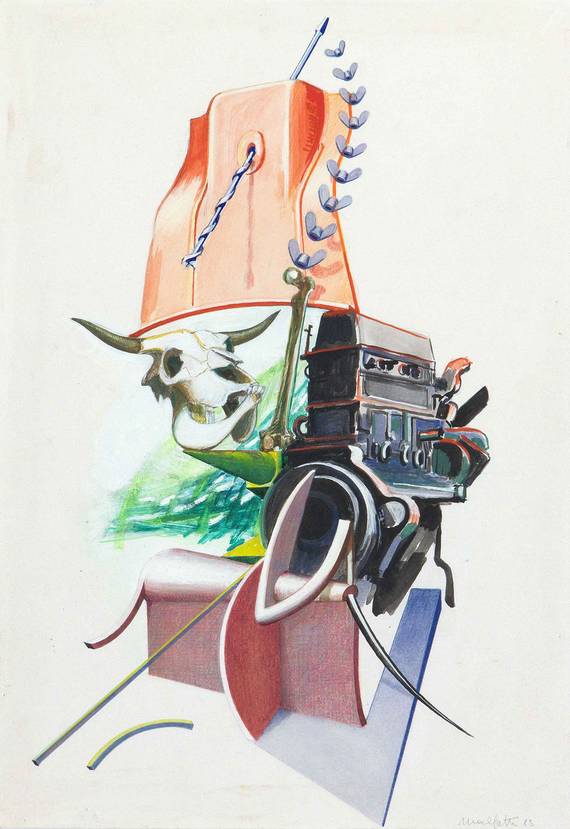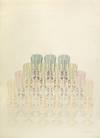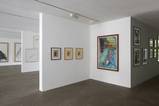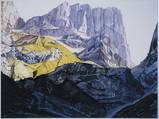Exhibitions 2010
Nino Malfatti
Bilder aller Zeiten / Images of All Time - The Graphic Work
 |
Nino Malfatti, Viele schöne Dinge, 1983. 43,3 x 30,2 cm. Tempera, Buntstift / Papier |
October 24th to December 26th, 2010
In this exhibition, we showed a selection of drawings by Nino Malfatti from his participation in documenta 6 (1977).
In an age of media art, it is very easy to forget about the original technical foundations of art such as drawing and painting and how great artists have aspired to fully explore the limits of technical feasibility in this regard.
On December 12th, 2010, a workshop discussion on Nino Malfatti was held with Nicholas Heidelbach.
" … In order to attest to my own knowledge and talent, I determined to explore the nature of the things that interested me. Countless sketches, studies, and designs were made. They were originally only intended as an outline for painting. But then, almost inevitably, the quality of a drawing alone was enough… " (from a statement by Nino Malfatti, 2010).
" … In this exhibition, Malfatti's artistic development over the past four decades is almost completely highlighted in retrospective … In more than 70 drawings, the painter's 40 years of creative development become evident… Neuenhaus shows large- and small-scale works done in lead and colored pencil, charcoal, pastel, or watercolor; reduced to grayscale or demanding qualities of color, set in the precise contour of a powerful and energetic stroke, or finely-tuned breathy hatching … The pictorial rhythm, always a surprisingly aesthetic interaction and an interplay between reality and abstraction, of familiarity and alienation, dominates the artistic microcosm of Malfatti. In this field of tension, he makes the formal pictorial claims to reality correspond and compete with one another, playing with ambiguity, irony, and deeper meanings.
His academic style of the 1970s features everyday objects in his early work, using such objects as hangers, plow blades, or shoe trees in his drawing themes. The highly figurative image of the object is more of a means for artistic purpose than actually the center of attention. By arranging the objects in a series, he gives them a structure and aesthetic rhythm.
During the 1980s, Malfatti discovered the landscape which now became his everyday objects, as well as adding new objects, such as screws, hinges, and gear rods. The realism of a landscape image is lost in this combination, any reference to reality quickly develops into bizarre and surreal imagery of the abstract and the fantastic.
In the new millennium, the objects of everyday life disappear from Malfatti's landscapes. The liberated gesture of a grand painter now defines the textures and structures of his sensitive landscapes - and the immense images opt towards mountainous formations. As in painting, the drawn "mountain scenery" of the Tyrolean alps that Malfatti creates focuses on alpine mountain formations, cliffs, or quarries. But Malfatti does not celebrate idyllic romantic realism or use the powerful nature of rugged mountain ranges as an accessory: The painter dissolves the viewed reality from its context and considers the mountains or stones as completely abstract objects. Their inexhaustible picturesque wealth is opened up, and from there comes his pictorial invention. So, even as Malfatti creates dynamic areas with light, shadow, shape, and color, the landscape provides an equal amount of structure to the work and helps the artist to create a highly aesthetic abstract piece of art. In conjunction with the title, this can often result in entirely new and unexpected metaphors. Malfatti is not a storyteller, but his exciting and evocative works always give the viewer enough inspirational impetus to associate their own stories …" (Quoted from Thomas Kriegisch in GN, Grafschafter Nachrichten. October 25th, 2010.)
Nino Malfatti lives and works in Berlin.
see also Exhibition in 2000.
A catalog was published in conjunction with the exhibition.
The exhibition was funded by the state of Lower Saxony and by the city of Neuenhaus.










